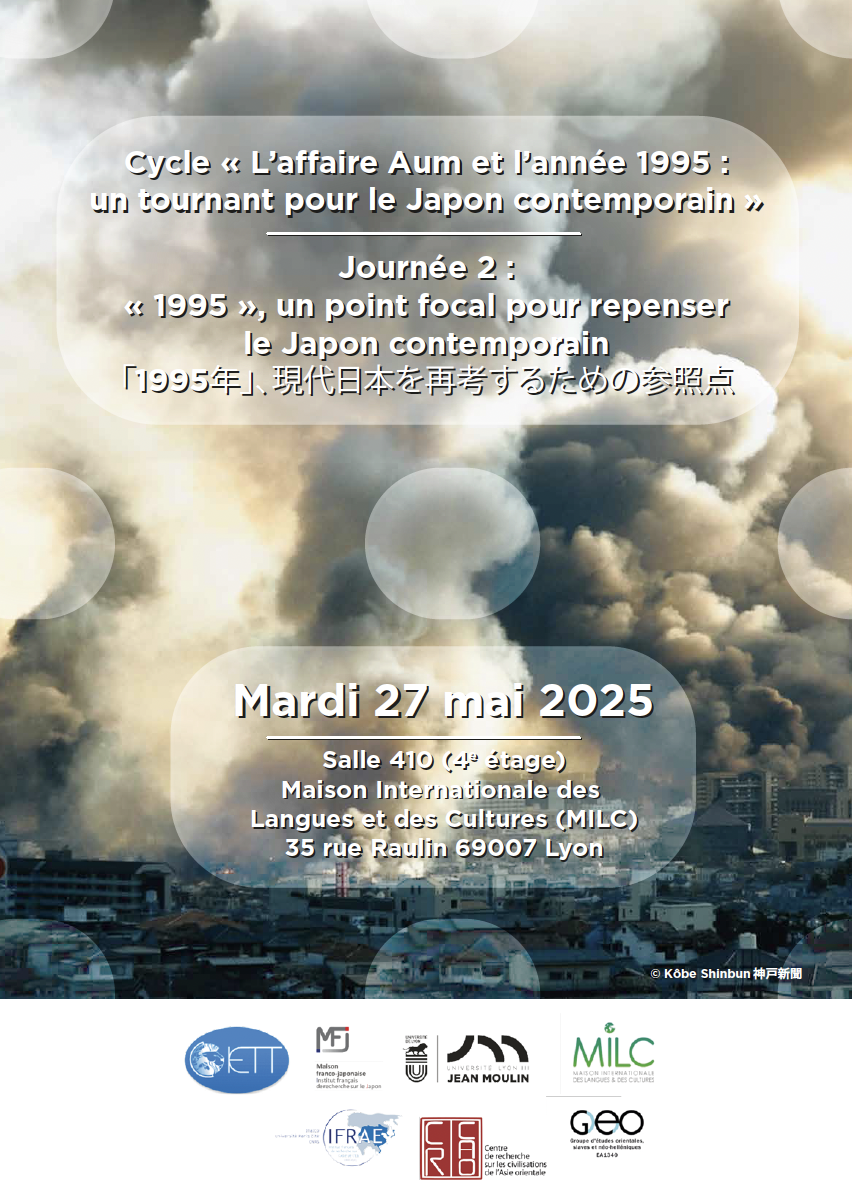Prochaine demi-journée d’étude organisée par le Groupe d’études de philosophie japonaise (Institut français de recherche sur l’Asie de l’Est, Inalco / Université Paris-Cité / CNRS) Samedi 24 mai 2025, en présence et vidéoconférence sur zoom, Amphi 5, 65 rue des Grands Moulins Paris 13e
14h00 -15h15 (l’heure au Japon 21h -22h15)
Scott MA (University of Zurich), « Angulo and Confucian Settler Colonialisms: A tentative Comparison, with Reference to the Japanese Empire »
15h30-16h45
Raphaël PIERRES (Centre d’Histoire des Philosophies Modernes de la Sorbonne), « Le problème philosophique de la pluralité des grammaires : une confrontation entre Joao Rodrigues et MOTOORI Norinaga«
=> Pour le lien Zoom, prière de contacter à partir du 21 mai : takako.saito@inalco.fr
Coresponsables : EBERSOLT Simon, KURODA Akinobu, KUWAYAMA Yukiko, MITTEAU Arthur, SAITÔ Takako, STEVENS Bernard, UEHARA Mayuko
Contact courriel : takako.saito@inalco.fr, akinobukuroda@gmail.com, simon.ebersolt@gmail.com arthur.mitteau@univ-amu.fr, yukikokuwayama@g.ecc.u-tokyo.ac.jp
_______________________
Japanese Philosophy Study Group
(French Institute for Research on East Asia, Inalco / Université Paris-Cité / CNRS)
Saturday 24 May 2025, in person and videoconference on zoom, Amphi 5, 65 rue des Grands Moulins Paris 13e
2.00 pm – 3.15 pm (Japan time 9.00 pm – 10.15 pm)
Scott MA (University of Zurich)
“Angulo and Confucian Settler Colonialisms: A tentative Comparison, with Reference
to the Japanese Empire”
3.30 pm – 4.45 pm (Japan time 10.30 pm – 11.45 pm)
Raphaël PIERRES (Centre d’Histoire des Philosophies Modernes de la Sorbonne)
“The philosophical problem of the plurality of grammars: a confrontation e
between Joao Rodrigues and MOTOORI Norinaga”
For the Zoom link, please contact from 21 May: takako.saito@inalco.fr
Coresponsables : EBERSOLT Simon, KURODA Akinobu, KUWAYAMA Yukiko, MITTEAU Arthur, SAITÔ Takako, STEVENS Bernard, UEHARA Mayuko
_________________________
Résumés :
Scott MA « Angulo and Confucian Settler Colonialisms: A tentative Comparison, with Reference to the Japanese Empire »
Recent historical scholarship on the Japanese empire has framed it as a form of settler
colonialism acquired through cooperation and learning from Western examples (Lu 2019;
Azuma 2019; Hirano 2023; Hennessey 2018). This paper critiques this assumption, arguing (1)
that a tradition of agrarian, state-directed settler colonialism was already well-established
within East Asia over thousands of years, independent from Western influence; (2) this tradition
of “Confucian colonialism” was the primary driver in the political logic explaining proposals to
colonize Hokkaido across the nineteenth century, before and after the Meiji Restoration; and (3)
these political traditions continued to be determinative in explaining Japan’s colonial policy
towards Taiwan after 1895, giving one possible explanation for deviances between Japanese
and European colonial models, most notably Japan’s consistent eschewing of indirect rule.
The presentation provides a bird’s-eye view of this history. It begins by examining the writing of
the ancient Confucian classics about the relationship between politics and land cultivation. It
then compares this with a basic understanding of Western settler colonialism, noting the
substantial points where they agree—the forced assimilation or decimation of indigenous
peoples, social fantasies projected upon land, and a connection between land reclamation and
social morality. It also notes important differences, most significantly the omnipresent role of
the state in Confucian colonialism and the absence of eschatological-theological motivations.
This mode of thinking is then shown to explain how Japanese politicians and intellectuals from
the late eighteenth century across the entirety of the nineteenth understood how the country
should defend itself from Russian incursions in Hokkaido, its northern frontier—by a two-pronged
approach, the state-sponsored sending of settlers coupled with the “acculturation” of
the aboriginal Ainu people. It lastly shifts the focus to Taiwan, showing how this Confucian
emphasis on cultural assimilation and improvement of “backwards” border regions was both
preserved during the colonization of Taiwan and adjusted to suit a modern world order via the
practice of “scientific colonialism” and the state-sponsored encouragement of economic
growth under capitalism.
Raphaël PIERRES « Le problème philosophique de la pluralité des grammaires :
une confrontation entre Joao Rodrigues et Motoori Norinaga »
Nous proposons de reconsidérer le problème philosophique du statut de la grammaire à l’aune d’une
histoire comparée des grammaires de la première modernité. Notre intervention se concentre sur la
mise en contraste de l’oeuvre de Norinaga Motoori avec celle de Joao Rodrigues.
De ce point de vue, la manière dont les grammaires jésuites des langues orientales ont été
mobilisées, à la fois dans les théories des langues au Japon, et dans la philosophie en Europe, est
décisive pour comprendre la constitution du concept de grammaire, et son usage élargi dans
l’épistémologie contemporaine. Dans une relation tendue à la logique, les grammaires ouvrent un
espace de discours et de savoir, à la fois descriptif et prescriptif.
Nous proposons ici de nous concentrer sur une relecture philosophique des ouvrages jésuites et tout
particulièrement de certains aspects du Nihon Daibunten (Arte da Lingoa de Iapam, 1604-1608) de
Joao Rodrigues. D’une part, il y a un écart entre la langue japonaise classique et les catégories
latines utilisées par les jésuites pour les décrire : en particulier la structure sujet-verbe-prédicat
paraît en décalage avec la langue japonaise.
D’autre part, une interrogation grammaticale naît très tôt au Japon, dans la prise de conscience de
l’écart entre la langue orale et les caractères chinois qui servent à l’écrire, et dans la tentative de
déterminer le statut de ce jeu entre langues. Dans ce cadre, nous cherchons plus particulièrement à
reprendre l’analyse de la contribution de Motoori Norinaga, et les concepts de teniwoha et kakarimusubi
(élaborés en particulier dans Teniwoha Himokagami, 1771 et Kotoba no Tama no O, 1779).
Comment saisir la spécificité de la grammaire japonaise dans son historicité, sans alimenter des
discours exotisants ou nationalistes ? Par là, faisant un pas de plus, quel sens philosophique donner
à la prise en compte de différences grammaticales effectives ?


